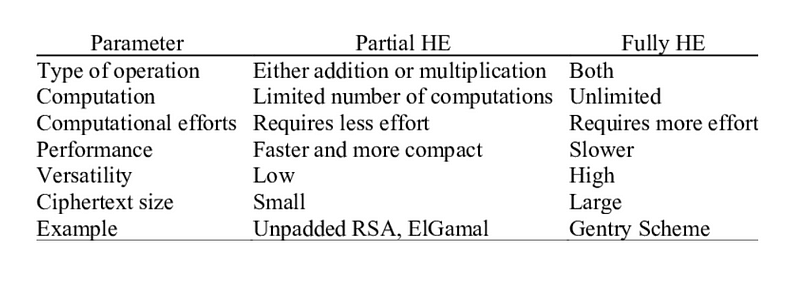What is Homomorphic Encryption Explained
Meaning, Types, Benefits, Challenges, and the Future Outlook

Homomorphic encryption is a type of encryption that allows mathematical operations to be performed on ciphertext (encrypted data) as if it were plaintext (unencrypted data). This means that data can be encrypted and then processed without having to be decrypted first, which has the potential to revolutionize the way we store, transmit, and process sensitive information.
The concept of homomorphic encryption was first introduced in the 1970s by MIT professor Martin Hellman, but it wasn’t until the late 2000s that practical homomorphic encryption schemes were developed. Today, homomorphic encryption is considered one of the most promising areas of cryptography research, as it has the potential to enable a wide range of applications in fields such as healthcare, finance, and government.
TLDR; Don’t have time to read? Here’s a video to help you understand What is Homomorphic Encryption in detail.
There are two main types of homomorphic encryption: partially homomorphic encryption and fully homomorphic encryption. Let’s understand each of them.
Partially Homomorphic Encryption
Partially homomorphic encryption allows only a limited set of mathematical operations to be performed on ciphertext. This means that data can be encrypted and then processed using a limited set of mathematical operations, but it cannot be fully decrypted without the appropriate keys.
One of the most well-known partially homomorphic encryption schemes is the ElGamal encryption scheme, which was first proposed in 1985. The ElGamal scheme is based on the concept of the Diffie-Hellman key exchange, and it allows the multiplication and addition of ciphertext. This means that it can be used to perform basic operations such as adding two encrypted numbers together, but it cannot be used to perform more complex operations such as decrypting the data.
Other examples of partially homomorphic encryption schemes include the Paillier scheme, which allows the addition of ciphertext, and the Goldwasser-Micali scheme, which allows the multiplication of ciphertext.
Partially homomorphic encryption has several benefits, including the fact that it is relatively easy to implement and that it is more efficient than fully homomorphic encryption. However, it also has some limitations, including the fact that it can only perform a limited set of mathematical operations on ciphertext.
Fully Homomorphic Encryption
Fully homomorphic encryption, also known as general-purpose homomorphic encryption, allows any mathematical operation to be performed on ciphertext. This means that data can be encrypted and then processed using any mathematical operation, and it can be fully decrypted without the need to perform any additional operations.
Fully homomorphic encryption is considered the “holy grail” of cryptography, as it would allow any computation to be performed on encrypted data without the need to decrypt it first. This would have numerous applications, including the ability to outsource data processing to the cloud without worrying about the security of sensitive data.
However, fully homomorphic encryption is much more difficult to implement than partially homomorphic encryption, and it is also much slower and more resource-intensive. As a result, fully homomorphic encryption has only recently become practical, and it is still an active area of research.
One of the most well-known fully homomorphic encryption schemes is the Gentry scheme, which was first proposed in 2009. The Gentry scheme is based on the concept of lattice-based cryptography and allows any mathematical operation to be performed on ciphertext. However, it is also much slower and more resource-intensive than partially homomorphic encryption schemes.
Other examples of fully homomorphic encryption schemes include the Brakerski-Gentry-Vaikuntanathan (BGV) scheme and the Homomorphic Encryption Standard (HES), both of which are based on lattice-based cryptography.
Fully homomorphic encryption has the potential to revolutionize the way we store, transmit, and process sensitive data, but it is still an active area of research with many challenges to overcome. Despite these challenges, researchers and industry experts believe that fully homomorphic encryption has the potential to significantly improve the privacy and security of data in the future.
Here’s the difference between partial and fully holomorphic encryption,

The Outlook
One of the main benefits of homomorphic encryption is that it allows sensitive data to be processed without exposing it to the risk of being accessed or tampered with by unauthorized parties. This is because the data remains encrypted throughout the entire process, making it much more secure than traditional methods of processing sensitive data.
Homomorphic encryption also has the potential to improve the privacy and security of cloud computing, as it would allow data to be processed in the cloud without the need to decrypt it first. This would allow organizations to outsource their data processing needs to the cloud without worrying about the security of their sensitive data.
However, homomorphic encryption is still an active area of research, and there are several challenges that need to be overcome before it can be widely adopted. One of the main challenges is that homomorphic encryption schemes are typically much slower and more resource-intensive than traditional encryption schemes, making them impractical for many applications.
Despite these challenges, researchers and industry experts believe that homomorphic encryption has the potential to revolutionize the way we store, transmit, and process sensitive information. As the field continues to advance, it is likely that we will see more and more practical applications of homomorphic encryption in the future.
You may also like,






